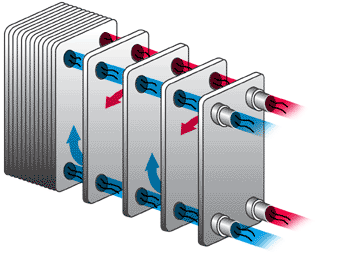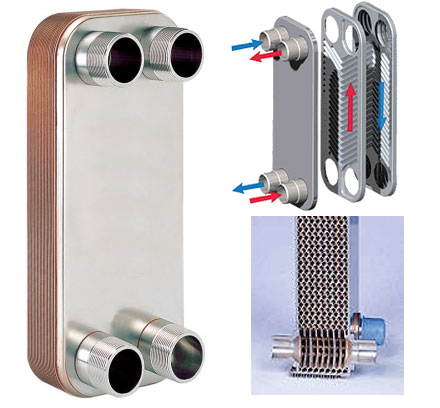Email: Sales@Jiawei-PHE.com
Tel:+86-0510-81618276
Fax:+86-0510-84060078
Mobile: +86-18681816635
![]() :Eric201066
:Eric201066
![]() :
18681816635
:
18681816635

Brazed Plate Heat Exchanger Feature
Standard design
Brazing the stainless steel plates together eliminates the need for sealing gaskets and thick frame plates. As well as holding the plates together at the contact points, the brazing material seals the package. Brazed heat exchangers are brazed at all contact points, ensuring optimal heat transfer efficiency and pressure resistance. The plates are designed to achieve longest possible lifetimes. Since virtually all material is used for heat transfer, the Brazed Plate Heat Exchanger is very compact in size and has a low weight and a low hold-up volume. We offers a flexible design that can be customized to meet customer-specific requirements. The brazed plate heat exchangers ensure the customer the most cost-efficient solution for his heat transfer duties.
 Models Cross Referance With Alfa Laval
Models Cross Referance With Alfa Laval
Material
The Brazed Plate Heat Exchanger consists of thin corrugated stainless steel plates which are vacuum brazed together using copper as the brazing material. Copper brazed units can be used for numerous of applications. However, for food applications and applications involving aggressive fluids, copper brazed units are not suitable.
Flow principle
The basic flow principle in a brazed heat exchanger for HVAC applications is parallel and current flow to achieve the most efficient heat transfer process. In a single pass design all connections are located on one side of the heat exchanger, making installation very easy.
Evaporator flow principle
The channels formed between the corrugated plates and corners are arranged so that the two media flow through alternate channels, always in opposite directions (counter current flow). The two phase refrigerant (vapor + liquid) enters the bottom left of the exchanger with a vapor quality depending on the operating condition of the plant. Evaporation of the liquid phase takes place inside the channels and some degrees of superheat are always requested, which is the reason why the process is called "dry expansion". In the enclosed evaporator picture the dark and light blue arrows show the location of the refrigerant connections. The water (brine) to be cooled flows counter current in the opposite channel; the dark and light red arrows show the location of the water (brine) connections.

Plate condensers – flow principle
The main components are the same as for the evaporator. The refrigerant enters at top left of the exchanger as hot gas and starts to condense on the surface of the channels until fully condensed, and is then slightly subcooled. The process is called "free condensation". In the enclosed condenser picture the light and dark blue arrows show the location of the brine connections. The refrigerant flows counter current in the opposite channel and is cooled. The light and dark red arrows indicate the locations of the refrigerant connections.
Dual system
The real dual circuit be patented in a solution with diagonal flow is obtained by means of pressed plates. The Brazed Plate Heat Exchanger can be connected with two independent refrigerant circuits. The special design ensures that each refrigerant circuit is in contact with the entire water flow. The main advantage is that at partial load (only one compressor running) water cooling is uniform and performance is maximized.
Multipass
The design options of the brazed heat exchanger are extensive. The heat exchanger can be designed as a multipass unit, different types of connections are available, and there is the option of choosing the location of the connections. We offers a wide range of standard heat exchanger models and sizes, tailor-made for HVAC applications and available from stock. Naturally, customer-specific designs are available on request.